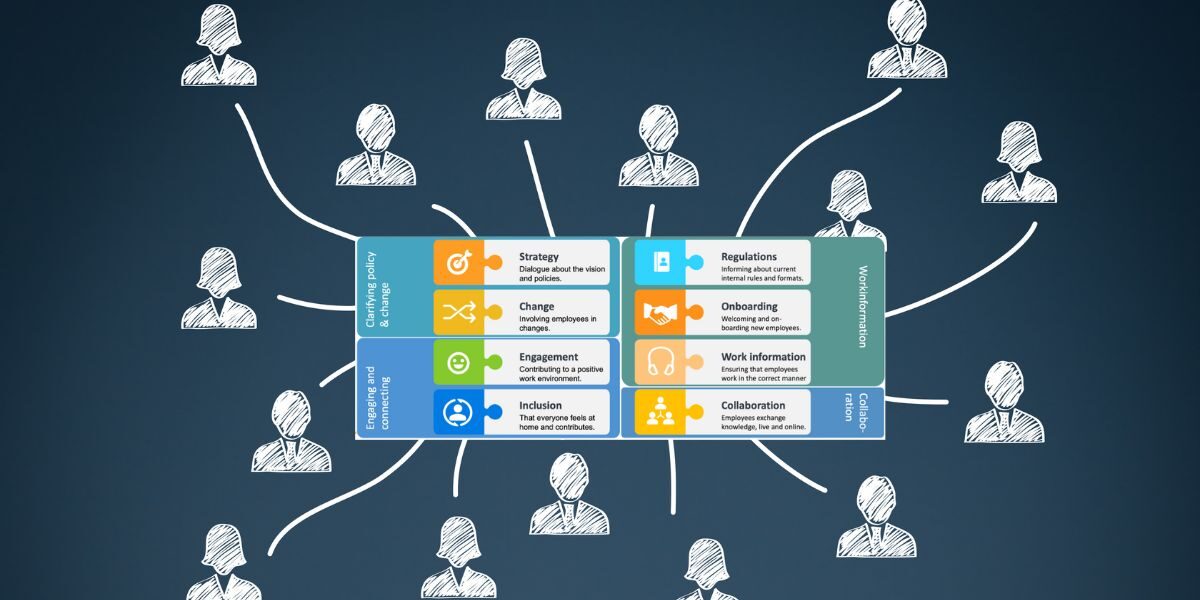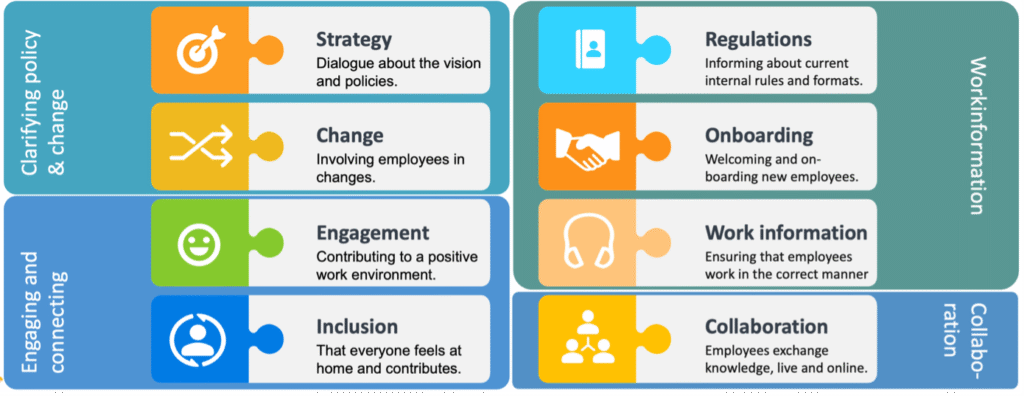The Four Core Functions of Internal Communication

Effective internal communication helps organizations operate more efficiently, stay aligned on a common purpose, and foster an environment where employees feel valued and heard. Broadly speaking, it serves four essential functions:
- Directing and driving change
- Engaging and retaining employees
- Enabling collaboration
- Supporting and optimizing work processes

“Internal communication is the invisible thread that ties vision to action and people to purpose.” – Huib Koeleman
1. Directing and Driving Change
Strategy: Facilitating dialogue around mission, values, and policies
Change: Involving employees meaningfully in transformation processes
Internal communication often starts with policy updates—delivered top-down—but it can and should be much more. Directing and driving change means building shared goals and providing clear direction for the whole organization. This can take many forms: managers blogging about policy changes, teams brainstorming new opportunities, department heads collaborating on strategic shifts, the works council hosting open discussions on the intranet, a director explaining new directions in a town hall, or team leaders unpacking what organizational goals mean for their department.
Success depends on knowing who needs what information, when they need it, and through which channel—combining top-down, bottom-up, and peer-to-peer communication.
Core Values, Brand Values, and Alignment
Policies should be understood in the context of the external environment. Internal communication plays a role in interpreting current events and linking them to strategy, providing stability and maintaining alignment in response to outside changes. Continuous discussion of the mission, values, and purpose keeps employees grounded and inspired. Talking about real customers instead of abstract goals increases engagement. Internal branding can turn employees into ambassadors—if brand and core values are genuinely aligned.
Change Communication
Large-scale change impacts people deeply—their work, their role, their sense of belonging. Effective change communication starts with a clear, shared vision. This vision underpins the communication mix and guides the approach. When done well, it helps people understand not just what is changing, but why, and how they fit into the bigger picture.
2. Engaging and Retaining Employees
Engagement: Creating a positive, motivating work climate
Inclusion: Ensuring everyone feels welcome, heard, and able to contribute
People want to be part of something meaningful. They seek work that allows them to develop in a supportive environment. The speed at which employees are informed and the extent to which they are listened to both shape that environment.
With hybrid work becoming the norm, connection requires conscious effort. The casual encounters of the office must be replaced with intentional moments: daily or weekly check-ins, department days, networking events, cross-team visits, and listening sessions. Even sharing social information—like birthdays—can help strengthen bonds.
Inclusion and Psychological Safety
Inclusivity means more than representation; it requires embracing diverse perspectives. That means fostering open, sometimes challenging conversations rather than settling for conflict-avoidant compromises. Psychological safety exists when people feel able to speak up, ask questions, and share ideas without fear of rejection or repercussion. Leadership communication is central here—leaders must actively model openness and respect.
3. Supporting and Optimizing Work Processes
Rules: Informing about internal rules, policies, and formats
Onboarding: Welcoming and training new hires
Professional Resources: Providing the knowledge needed to perform effectively
Expertise is vital, but every organization also has its own way of working. This may include documented protocols, scripts, style guides, or unwritten cultural norms—sometimes explicitly taught in onboarding, sometimes learned gradually through experience. In many cases, “this is how we do things here” becomes part of the organizational DNA.
Work process information can live in manuals, online documents, or shared platforms. Production-focused organizations often have highly standardized procedures, requiring easy-to-access (often digital) manuals and peer support.
Traditionally, communication teams had little role in distributing work process information. But with integrated platforms like MS Teams and SharePoint, the boundaries between policy communication and work communication have blurred. Today, communicators are often essential to making sure this information is clear, consistent, and accessible—helping employees work more efficiently and confidently.
4. Enabling Collaboration
No one works in isolation. Employees rely on each other’s knowledge, experience, and creativity to achieve results. This collaboration can happen in person, but also depends heavily on storing, sharing, and making knowledge accessible.
Work information and collaboration increasingly overlap. Few projects can be completed by one person alone; effective knowledge exchange is vital. While AI and digital platforms make it easier to locate expertise (“Colleague X also read this document”), technology alone is not enough. Spontaneous encounters, brainstorming sessions, and the informal sharing of ideas remain irreplaceable catalysts for innovation.
Many high-performing companies—like Tesla and Google—encourage on-site collaboration because they believe strongly in the creative and problem-solving power of in-person interaction.
Internal Communication as a Strategic Driver
Internal communication is not an end in itself—it is a strategic enabler. By explicitly linking communication functions to organizational goals, leaders build stronger alignment and support. In a world where organizations are more networked and flexible than ever, internal communication sits at the core of efficiency, collaboration, innovation, and engagement. When employees are truly engaged, they experience more meaning in their work, stronger relationships with colleagues, and greater personal satisfaction. Internal communication fuels this by fostering connection, recognizing contributions, and ensuring every voice matters.
Done well, it not only informs but inspires, connects, and drives the organization forward.
Huib Koeleman


